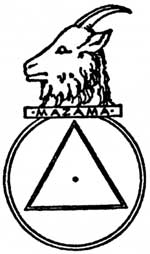|
Volume XXV - 1994
Christened Mount Mazama
By Fay Fuller
Editor's note: This article appeared in the Tacoma Ledger
on September 6, 1896. Excerpts are reprinted here to show how the
Mazamas' special relationship with Crater Lake began. Their excursion to
the lake occurred almost six years before establishment of the national
park but this outing inspired the first formal talks aimed at
interpreting Crater Lake and its surroundings. Reports from the three
scientists mentioned appeared in the 1897 edition of Mazama, the
club's yearbook.
The Mazamas have just returned from their annual outing. They
climbed Mt. Pitt [McLoughlin], christened Mount Mazama, and illuminated
Crater Lake and Rogue River falls. It was the most successful expedition
yet chronicled by the society's historian and to be long remembered by
hundreds who met from several states to explore the summit of the
Cascades in the heart of Oregon. In point of numbers it was an important
occasion, and it is estimated by one of the government scientists, who
was established three weeks at the lake, that nearly 1000 men and women
were encamped upon its banks. Of these perhaps seventy-five were
Mazamas, members of the northwestern organization of alpine climbers,
all of whom have ascended at least one mountain over 10,000 feet high.
None others need apply, for this club purposes to have only genuine
mountain enthusiasts identified with its accomplishments.

Portion of the Mazamas' leaflet promoting their trip
to Crater Lake.
Courtesy of the Klamath County Museum.
To me Crater Lake is the most impressively beautiful body of water
in all the world that I have found. It lies on the very ridge of the
Cascades, in Klamath County, southern Oregon. [The lake is] five or six
miles in diameter, nearly circular, the vast crater of an extinct
volcano...
Wagons may be driven to the very edge of the mountain that contains
the lake, where it breaks suddenly off into abrupt spurs and rough
precipices that plunge directly 2000 feet below into almost unknown
depths. This volcano-hewn rim, unpolished and severe, extends for
twenty-five miles around and above the lake, marking the contour of the
huge pit wherein the water serenely lies...
In the western portion of Crater Lake rises Wizard Island, a perfect
cinder cone...Its steep, sliding walls of pumice, sparsely covered with
evergreen timber, make tedious climbing. The top breaks off suddenly
into a depression, one hundred feet deep and about four hundred feet in
diameter, known as the Witch's Cauldron. Here the Mazamas held their
business meeting, electing a number of new members, many of whom had
only qualified a few days before, on the summit of Mt. Pitt. The same
evening witnessed the most important ceremony of the expedition.
Several hundred people gathered around a huge camp fire to celebrate
the christening of a once majestic mountain, unnamed throughout time's
changes, and remarkable for the deep blue cup it has for centuries
protected. Appropriate toasts were offered, introducing interesting
facts on the geology and nomenclature of the lake, its fish and fish
foods, forest preservation, trees and plants and the wonderful features
of the adjacent mountains. The culminating event was the christening of
"Mount Mazama" over those rugged slopes. I had the honor to break a
bottle filled with melted snow brought from its last crater. The name
Mazama will be entered upon the government maps and remain in use. This
is right inasmuch as no original name has been sacrificed to commemorate
our society...
One of the most interesting features of the expedition, enhancing
materially the Mazamas' pleasure, was the presence of several of the
government's most eminent scientists, who pursued their various studies
and observations during our stay. Their interest in the society and
participation in its plans was fully appreciated by the members. Every
evening instructive talks were held around camp fires, and in the day
time these gentlemen accompanied several investigating expeditions
around the lake.

A South American mountain goat is the Mazama's
namesake. The group's logo highlights this connection and features the
U.S. Coast and Geodetic Survey symbol for mountain peaks.
|
Frederick Coville, chief government botanist, exhibited a collection
of plants growing in this vicinity, and gave a number of interesting
talks on their distribution and growth. Several unusual species are
found, and among the trees are noticed the noble fir, Alpine hemlock,
and Tamarack pine.
Dr. C. Hart Merriam, assisted by Prof. Bailey and other scientists,
made a collection of twenty-five different species of mammals,
forwarding all the specimens to the Smithsonian Institution. Mr. J.S.
Diller is known as the volcano sharp of the government geological
survey. One of his favorite retreats is Crater Lake, which he considers
more wonderful than any body of water known. He is now engaged in a
geological map of the same and has been spending several weeks making
observations for this particular work. He is an interesting, and at the
same time economical speaker, with the faculty of weaving facts into a
charming drapery of language. In fact, contact with these men of exact
knowledge is most instructive and on this occasion made doubly
fascinating the freedom, the enjoyment and the witchery of the
mountains.
|

